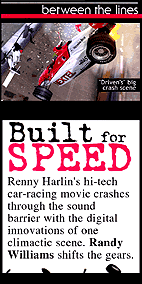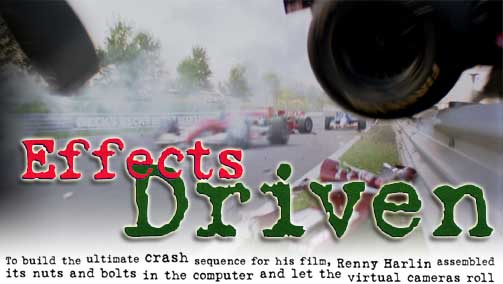By Randy Williams In "Driven," director Renny Harlin's
film about the world of open-wheel car racing, the stars include Sylvester Stallone (who
also wrote the screenplay), Gina Gershon, Estella Warren, Til Schweiger, Kip Pardue and
Burt Reynolds. But the marquee names take a back seat to the scene stealer already on view
in the movie's trailer -- the technology and ingenuity that created the spectacular
"Memo crash."
The crash sequence -- less than two minutes on screen -- is the technical centerpiece
of a film that, says Harlin, was designed to raise the bar once more for the constantly
evolving world of feature effects. "My goal was to do for car movies what 'The
Matrix' did for action movies, " the Finnish filmmaker says. "I wanted to
explore and define new ways of shooting and more than anything ... how to put the audience
in the driver's seat."
Harlin says he realized early on his temperamental star would demand teamwork, weeks of
planning and the specialized services of computer artists and technicians. Indeed, the
specific look the director wanted to achieve ruled out a number of traditional methods of
staging the crash.
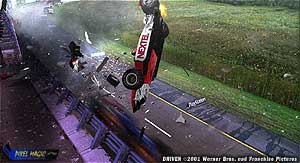
Artists at visual effects house Pixel Magic produced
entirely computer generated visual effects shots for DRIVEN, including this shot from the
climactic 'Memo's Crash' sequence. Click on the image for a larger view. |
Stunt drivers could not be employed because open-cockpit race cars afford them no real
protection in a crash. Radio-controlled vehicles were equally problematic. Although a
remote-control system was devised to crash cars traveling more than 100 mph, the signal
could be interrupted by a kid with a walkie-talkie who happened to be in the area using
the same wavelength.
It was Harlin's effects coordinator Brian Jennings who came up with a viable solution.
He fashioned a complex pulley system that could tow a car rigged with explosives and
breakaway parts at a very high speed to a designated mark, where it could be detonated.
Nearly two dozen of the crash cars were constructed, but the real trick was to get the
fabricated vehicles to break up precisely as a real one would. "Renny worked it out
with a physicist," Stallone says, "that if a car was stalled on the track and
another one hit it at 200 mph, the end result would be that it would fly eight stories in
the air and travel nearly 400 feet. It would have that kind of reaction."
Shot on a test track in Montreal using as many as 16 cameras, Harlin captured the Memo
crash (named after a character in the film) from every conceivable angle. The director
used Rollvision -- a remote-controlled camera head that can tilt 180 degrees as well as
roll and pan 360 degrees -- along with a very small camera called the Eyemo, which was
rigged to a car's suspension for a fast-moving perspective.
"In terms of the shooting and editing style, Renny wanted a very real and raw feel
using lots of cameras and (he was) not particular about perfect focus," Jennings
says. "It is in some ways like a documentary, real-life feel so that you're in the
car and things are shaking and not perfect."
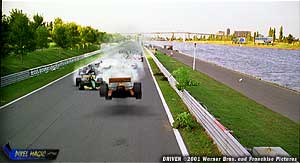
Only two of the ten racecars featured in this shot actually
exist in real life. All other elements of the shot (eight racecars, shadows, tire and
engine smoke) is computer generated. Click on the photo for a larger image. |
In addition to the various camera cranes, which moved above, around and among the
racing cars, Harlin also employed a FotoSonics camera, which shot more than 300 frames per
second to capture the fiery explosions. He even used cameras in steel casings so that the
cars could actually crash into them to give the effect of debris flying right into the
audience. (To create the slow-motion visuals for the crash scenes, "Driven" used
an Arriflex 435 motion picture camera, whereas "The Matrix" relied on a series
of still cameras to achieve it "hang time" effect.)
In filming this sequence, only one car could crash on the wires -- it wasn't safe to
have other vehicles driving near the rigging. So, Harlin shot it knowing he could add
computer-generated (CG) race cars later in post-production.

Ray McIntyre Jr., a visual effects supervisor at digital effects house Pixel Magic, was
commissioned to create those CG cars, as well as generate virtual rain and fan-crowded
grandstands for other racing sequences. Using Pentium-based computers with Windows 2000
operating systems and Lightwave 3D software, along with Apple Macintosh G4s running Adobe After Effects and Pinnacle Systems' Commotion, the crew at Pixel Magic began the complex
technical process of digitally building the Memo crash.
Portions of the effects work were based on a computer model of one of the leading race
cars, a Reynard, which had been furnished by Jennings. "Reynard supplied us with a
diagram and a parts list, so we built a computer car with all the same parts as the real
ones," Jennings says. "Body surfaces, bolts, aerodynamics, even signage -- our
computer car had all the same dynamics as the real ones, so when we simulated the crashes
all the pieces would be there to analyze."
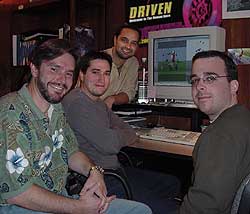
(from left to right) Pixel Magic visual effects supervisor
Raymond McIntyre, Jr., 3D supervisor Micheal Hardison, compositing supervisor Todd Vaziri,
visual effects producer George Macri. Click on the photo for a larger image. |
The first phase took about 10 days and primarily involved animatics or
previsualization, which McIntyre describes as storyboarding in the computer.
"Renny wanted something no one had ever seen before, no race fan, no
moviegoer," he says. "In describing his goal, Renny said he wanted an
'out-of-body' experience for the fans of what the driver was seeing. That meant the driver
in a crash reacting to the crash and everything in his immediate surroundings (fire,
debris) is in slow motion, but the world is in real time. The other race cars are whizzing
by almost hitting him in real speed, yet the rain and flying debris are in slow motion.
"Because the filmed crash didn't have the climactic effect they'd hoped for,"
McIntyre adds, "we took the first 2-3 cuts of the real crash and merged it with the
remaining dozen cuts in computer animation. To do that seamlessly was a very, very
complicated process."
In order to re-create the exact details from the filmed sequence, Pixel Magic basically
"created geometry in the computer," he says. "Like an architect would in
his renderings, we created in the computer a three-dimensional wire frame of the track
surface, the guardrail, the billboards and off in the distance the sky and trees."
The effects designers were then able to map an image onto the geometry that allowed
them to "move" the camera to change the mood of the shot or alter a given
perspective. "We made virtual camera moves out of video plates that didn't have
camera moves in them to begin with," McIntyre explains.
Bridging real footage with computer-generated images in an almost continuous fashion
was made possible by Pixel Magic's compositing supervisor, Todd Vaziri, who came up with a
transition method called a 'Slingshot,' McIntyre says. "What that slingshot
does," he says, "is take the audience into the driver's out-of-body experience.
The driver (crashes into) the guardrail as we go from the real car crash to the CG crash.
The scene begins to kind of vibrate like a high frequency and zooms in via tiny
increments. Then, all of a sudden (the point of view) rushes into the helmet of the driver
and pulls back in a reverse method of that high-frequency shake and zoom technique into
the first total computer-generated shot.
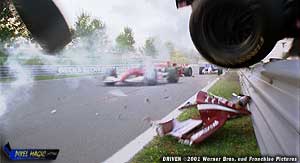
Four computer generated cars, tire smoke and engine smoke
were added to this intense scene, where a racecar actually hits the camera sending it
flying. Click on the photo for a larger image. |
"That's an indication that we rushed into the driver and pulled out and you, the
audience, are now feeling what the driver feels and sees as he experiences it,"
McIntyre continues. "As opposed to a race fan who sees everything go by in real time
and barely has time to react to it, you are now experiencing what the driver is, which to
him is trying to save his life. He's doing everything in his power to deal with (the
crash), so therefore it's not happening as fast to him as it does the person watching it.
That is what the first transition from the real crash to the first CG shot shows you. From
that point on, everything is computer generated."
With his team of Vaziri, CG 3D supervisor Micheal Hardison and visual effects producer
George Macri, McIntyre presented the finished sequence to Harlin and Jennings. Afterward,
the Pixel Magic crew made some adjustments based on their comments, and the director and
Jennings met with the film's editor, Stuart Levy, to edit the previsualization piece into
the sequence.
Although the Memo crash might get less than one percent of the film's screen time,
those few moments reflect the attraction of virtual technology for an action-oriented
filmmaker and the advances made since the release of earlier racing movies -- such as
"Grand Prix," "LeMans" and "Days of Thunder" -- all of which
were considered technically adept for their time.
"This film could be done completely practically with no visual effects,"
Harlin says, " but our ability to digitally modify the action and cars enhances the
live racing footage, allowing us to move the camera seamlessly and show you new things in
new ways. With 'Driven' you are dealing with absolute reality and people know what things
look like. So no matter how good the technology is, with reality-based films especially,
you have to conduct your shots so that they are believable and not an unreal exercise
removed from accurate storytelling."
Pixel Magic's web page: http://www.pixelmagicfx.com
DRIVEN Home Page: http://www.what-drives-you.com
DRIVEN (c) 2001 Warner Bros. and Franchise Pictures
The Hollywood Reporter: http://www.hollywoodreporter.com
